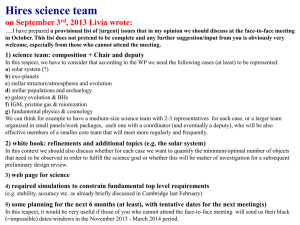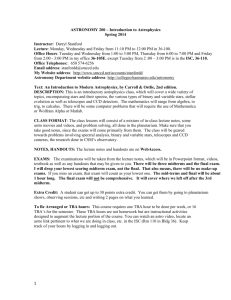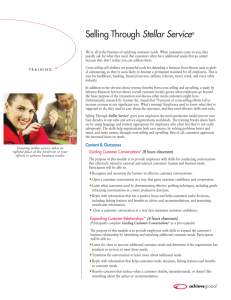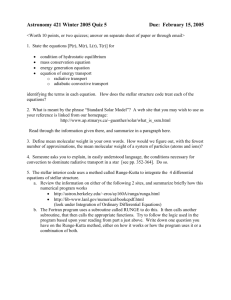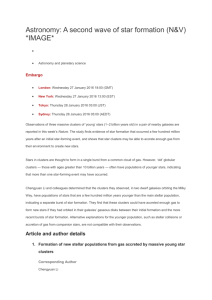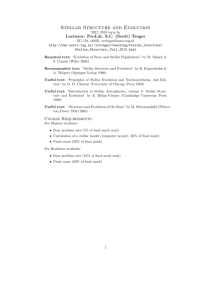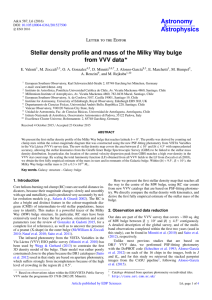HSC Astrophysics Sample Assessment Task
advertisement
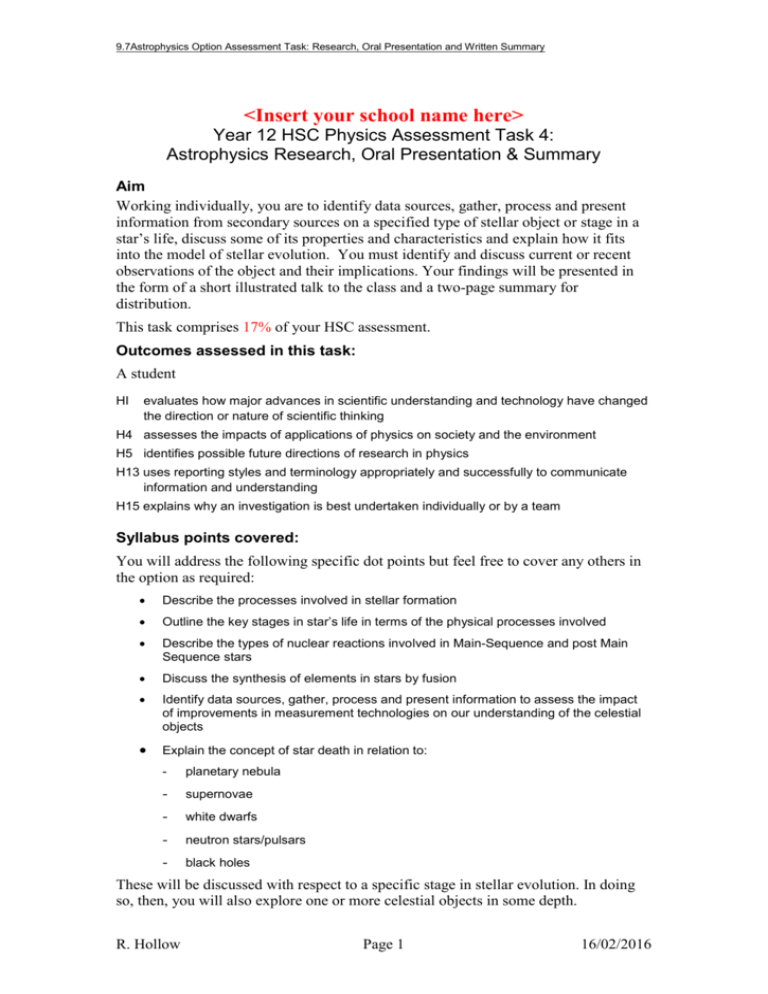
9.7Astrophysics Option Assessment Task: Research, Oral Presentation and Written Summary <Insert your school name here> Year 12 HSC Physics Assessment Task 4: Astrophysics Research, Oral Presentation & Summary Aim Working individually, you are to identify data sources, gather, process and present information from secondary sources on a specified type of stellar object or stage in a star’s life, discuss some of its properties and characteristics and explain how it fits into the model of stellar evolution. You must identify and discuss current or recent observations of the object and their implications. Your findings will be presented in the form of a short illustrated talk to the class and a two-page summary for distribution. This task comprises 17% of your HSC assessment. Outcomes assessed in this task: A student HI evaluates how major advances in scientific understanding and technology have changed the direction or nature of scientific thinking H4 assesses the impacts of applications of physics on society and the environment H5 identifies possible future directions of research in physics H13 uses reporting styles and terminology appropriately and successfully to communicate information and understanding H15 explains why an investigation is best undertaken individually or by a team Syllabus points covered: You will address the following specific dot points but feel free to cover any others in the option as required: Describe the processes involved in stellar formation Outline the key stages in star’s life in terms of the physical processes involved Describe the types of nuclear reactions involved in Main-Sequence and post Main Sequence stars Discuss the synthesis of elements in stars by fusion Identify data sources, gather, process and present information to assess the impact of improvements in measurement technologies on our understanding of the celestial objects Explain the concept of star death in relation to: - planetary nebula - supernovae - white dwarfs - neutron stars/pulsars - black holes These will be discussed with respect to a specific stage in stellar evolution. In doing so, then, you will also explore one or more celestial objects in some depth. R. Hollow Page 1 16/02/2016 9.7Astrophysics Option Assessment Task: Research, Oral Presentation and Written Summary Research Two periods will be allocated for you to spend in the Library. During these periods you are to identify data sources, gather and process information on your selected stellar object. You are to locate information about the state of current research on your stellar object. You are required to access information from at least three different sources such as popular scientific journals, CD ROMs, newspaper articles, books and the Internet and include full details in a bibliography in the correct format. Stellar Objects One of the following stellar objects will be selected randomly in class and assigned to you: 1. Pre-Main Sequence stars (including T Tauri types) 2. Main Sequence stars 3. Red Giants/Supergiants 4. Planetary nebulae/white dwarfs 5. Supernovae 6. Neutron stars/pulsars 7. Stellar mass black holes Preparation of the Presentation A. Oral presentation The first part of your presentation will be a ten minute ( 2 minutes) illustrated talk to the class about your designated class of object. In it, you must; 1. Provide a description of the class of stellar object, its, size and physical properties and where this type of object is typically located. 2. Explain where the class fits into the model of stellar evolution. 3. Describe the physical processes that provide the energy in the object. 4. Discuss which wavebands it is observed at and why, with respect to the information obtained at different wavebands. 5. Discuss at least two recent observations (ie within the last five years) made by astronomers from two separate teams or institutions. Outline how they made their observations, what they found and how their findings helped develop the model of stellar evolution. You should make specific mention of the value or otherwise of any collaborations between individual astronomers or groups in planning and conducting observations. 6. Evaluate how discoveries about this type of object have contributed to the development of scientific knowledge and what, if any has been the impact on society. 7. Outline any outstanding questions still to be answered about the type of object and what observations are planned for the future. R. Hollow Page 2 16/02/2016 9.7Astrophysics Option Assessment Task: Research, Oral Presentation and Written Summary Your talk must be supported by use of relevant diagrams or illustrations. These can be on overhead transparencies, Power Point presentation, slides, charts, and drawings on the board or books using a document camera. Basic resources for illustrations will be provided but you will have to plan ahead and use the two allocated periods wisely. If you require any special equipment or needs, notify me early on so plans can be made. B Summary for distribution In addition to your talk you must submit a two-page (A4) summary of your research. This must be suitable for distribution to your peers and should act as a useful set of notes when combined with the others. These summaries will be copied and distributed. Use relevant diagrams to supplement your notes. C Bibliography You are to submit a complete bibliography of all sources used. The bibliography is to be annotated; that is, it should contain a brief outline of each source, its intended audience, value, currency and relevance. The bibliography is in addition to your two-page summary (ie does count in the two A4 pages). Date for Talks <add your own details here> This set of marking sheets must be submitted at the time of your talk. R. Hollow Page 3 16/02/2016 9.7Astrophysics Option Assessment Task: Research, Oral Presentation and Written Summary Oral Presentation Marking Sheet Name/Number: _______________________________ Topic: _____________________________ Structure: Introduction: 0 _____________ 1 Conclusion: 0 _____________ 1 Use of Notes: 0____________ 1 ___________ 2 _____________3 consistent reading frequently spoke without notes Delivery: 0 ____________ 1 ____________ 2 no eye contact regular eye contact 0 _____________ 1 ____________ 2 lack of expression good vocal intonation Language: 0 _____________ 1 ____________ 2 appropriate scientific language used Support Media: 0 _____________ 1 ____________ 2 no support media good support media provided 0 _____________ 1 ____________ 2 support media not well used effective use of support media Timing 0 __________ 1 Presentation Total /16, divided by 2 = /8 allocated time + or – 2 minutes Content of talk 1. Description/properties of object 0_______1_______2 2. Fit in model of stellar evolution 0_______1_______2 3. Physical processes/energy source 0_______1 4. Wavebands for observations 0_______1 5. Two recent observations 0_______1_______2________3________4 6. Contribution to scientific knowledge 0_______1_______2 7. Questions/future observations 0_______1_______2 Content Total R. Hollow Page 4 / 14 16/02/2016 9.7Astrophysics Option Assessment Task: Research, Oral Presentation and Written Summary Astrophysics Research, Summary & Bibliography MARKING SCHEME Summary for Distribution 6-8 A student will: 1. Extract relevant information from diagrams and/or numerical data in graphs and tables as well as from written text; 2. Synthesise and summarise information from sources in a logical, concise, coherent and organised manner; 3. Present an effective and useful summary of the required length and format (two A4 pages); 4. Utilise one or more relevant diagrams or illustrations in the summary to aid in the presentation of information; 5. Address the required content areas and questions. A student will: 1. Extract some relevant information from numerical data in graphs or tables and from written text; 2. Synthesise or summarises information from sources such that the information has been processed, not just reproduced; 3. Present a summary of the required length and format; 4. Utilise one or more diagrams or illustrations that relate to the telescope; 5. Address many of the required content areas and questions. A student will: 1. Extract some information from data in graphs or tables and from written text; 2. Presents a summary that shows poor synthesis of information. 3. Present a summary of between one to three A4 pages; 4. Use one or more diagrams or illustrations; 5. Address a few of the required content areas and questions. R. Hollow Page 5 3-5 0-2 Total/8 __________ 16/02/2016 9.7Astrophysics Option Assessment Task: Research, Oral Presentation and Written Summary Bibliography 3-4 A student will: 1. Select at least three relevant sources from which to collect information; 2. Construct a brief, accurate outline of each information source which includes the main points; 3. Correctly assess the accuracy of the scientific information in each source; 4. Select and use an appropriate method to acknowledge the sources of information; 5. Evaluate each information source for its value, currency relevance and identify the intended audience. A student will: 1. Select fewer than three relevant sources from which to collect information; 2. Construct an outline of each information source including some of the main points; 3. Attempts to discuss the accuracy of the scientific information in each source; 4. Acknowledge the sources of information; 5. Describe some of the following aspects of each source: the value, currency relevance and identify the intended audience. 0-2 Total/4 Total/12 Additional marker’s comments: /14 Summary /8 Bibliography /4 TOTAL R. Hollow Page 6 /8 Oral presentation Content of talk /34 16/02/2016


